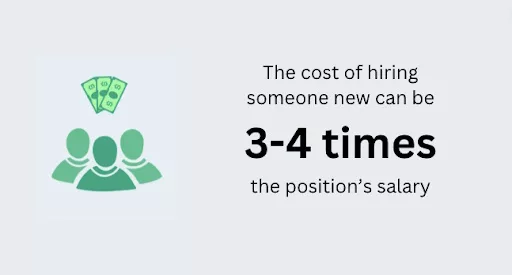
All staff departures cause temporary disruption. But when a board member, director, or manager leaves your organization, it can plunge your nonprofit into chaos. That’s why nonprofits often choose to create a succession plan.
This article will look at why a succession plan is so important in the nonprofit sector and how to create one that protects your nonprofit for years to come.
The importance of succession planning in nonprofits
A succession plan is a strategy that outlines the steps that need to be taken if and when a key leadership staff member vacates their role. It involves identifying crucial positions and devising a plan that aids the smooth transition of another qualified person into the role, internal or external.
Succession planning prepares you for unexpected resignations, retirement, and other planned and unplanned vacancies. It minimizes the disruptions that arise when key members leave your organization, such as high recruitment costs, decreased productivity, and donor anxiety.
How to create a succession plan for your nonprofit
In the event of a key personnel’s departure, your nonprofit can continue to thrive with a succession plan. Let’s walk through how to create one for your nonprofit.
Identify key leadership positions and job descriptions
Every role in a nonprofit is invaluable. But some crucial roles are particularly difficult to fill. Without a competent person in that role, vital operations will fall apart.
Your Board Members and Executive Directors are key leadership positions that require succession planning. But many other roles are central to your operations, such as your Director of Philanthropy and Program Manager.
Many nonprofits also have highly specialized roles. For example, if you provide mental health services, your counselors will be fundamental to your organization.
Start by identifying your nonprofit’s key leadership positions and roles. Which positions play a central role in strategic operations? Which roles are the most difficult and expensive to fill? This will enable you to plan in order of priority.
Identify staff members with leadership potential
You may struggle to find an external hire who connects with your nonprofit’s core values, aligns with your culture, and possesses relevant experience. Ultimately, this leads to lengthy hiring processes, potential turnover, and severely disrupted operations.
External hiring is also expensive. According to the Society for Human Resource Management, it can cost 3-4 times more than the position’s salary to hire someone new.

Instead of relying on external talent, identify current staff members with leadership potential.
Do you have any staff who are particularly hard-working and motivated? Eager to learn? If so, you can train these staff members to step into leadership roles. As a result, you’ll reduce operational disruption and lower hiring costs.
Set clear succession goals and objectives
What is the goal of succession planning for your nonprofit? Sure, you want to find successors for leadership roles. But what will this look like in practice?
Setting clear goals and objectives aligns your leadership team with a united vision of your succession plans. If visions aren’t aligned across the board, disputes and conflicts may arise.
To establish your succession goals and objectives, ask yourself the following questions:
- Which roles and positions require a succession plan?
- What are the responsibilities for these roles?
- What skills, experiences, and values are required for each role?
- Will you be hiring internally or externally?
- Who will be involved with the hiring and onboarding process?
Encourage cross-training among staff members
Cross-training involves training a staff member to handle some of the tasks and responsibilities performed by a different staff member. Essentially, it teaches employees how to do each other’s jobs, which can prepare them for potential succession.
For example, you could use cross-training to teach your project coordinator how to handle the duties of your program manager. If your project coordinator vacates their role, the project coordinator would be able to smoothly step into the role.

Cross-training requires the support of both parties. So, why not incentivize participation by offering benefits? Arrange for the two members to go out to lunch together or to an educational event. Not only can they spend time sharing knowledge, but they can build a positive relationship, too—Just remember to reimburse them for food, travel, or tickets.
Stress the importance of ongoing plan review
Succession planning is an ongoing process. It’s natural that your plan will change over time in response to shifts in your nonprofit’s larger strategy. Conduct periodic plan reviews that evaluate your initiatives in the context of the current socio-economical landscape.
Emphasize transparent communication about the plan
Should you tell employees they’re part of a succession plan?
Absolutely. From your board and executives to your employees and volunteers, everyone should be aware of the fundamentals of your plan. They should know who is governing the succession plan and what the process entails.
Hold regular meetings to have in-depth discussions about developments. Provide equal access to succession plan documents and governance information via a secure document-sharing platform.
Allocate budget for leadership training and recruitment
Filling key leadership roles is going to come at a cost. For external recruitment, you’ll need to cover the costs of job advertising, screening, and onboarding. For internal hires, you’ll need to accommodate the costs of training.
Use specialized accounting software for charities and nonprofits to help you accurately allocate recruitment and training budgets. Accounting software gives you a 360-degree view of your accounts, recording your incoming donations and outgoing expenses in real-time.
Once you’ve used this information to establish a budget, you can reliably track your weekly and monthly budgeting.

Expect costs for temporary staffing or consulting fees
Even the most thorough succession plan can’t prepare you for every situation. Maybe the successor you had in mind needs more training. Maybe they are unavailable.
In a succession crisis, costs can spiral rapidly. Expense management software for small business can help your nonprofit track expenses and adapt accordingly. It’s also useful to set aside a budget for temporary staffing or consulting fees.
Start succession planning today
Don’t wait until a key leadership member leaves your organization to think about succession. Get a succession planning team together and go through the steps we’ve outlined above, ensuring that all of your members are aligned with your initiative.
Worried about the budget for your succession plan? Set up a fundraising campaign using an online fundraising platform. Inspire supporters to help by communicating why having experienced personnel on board is so critical to your organization’s cause. You can set up fundraising campaigns for your leadership training, too.



